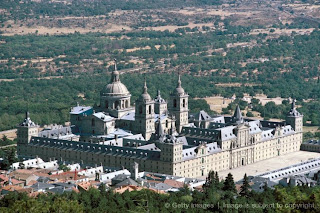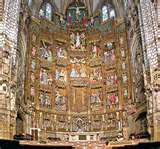The next morning we had an early breakfast and checked out of out hotel. We loaded up the bus and headed north. Our destination was the city of Logrono one hundred and fifty miles north on the Ebro River. But before we made the trip to Logrono, Ed made arrangements to visit El Escorial, 28 miles north west of Madrid. There we planned to see he royal mausoleum, museum, library, the pictorial map room, and the Titian painting of St Lawrence.
 |
| The yellow star marks Escorial |
We no sooner got under way, when we heard yelling from the back of the bus, "Air!, Air! AIR!..."
The rowdy ones in the back were complaining again. Their complaint was well deserved, however, because in time we all felt the need for air conditioning. Ed was sitting in the front talking with the driver who was trying to get the air to come on. Finally, he decided to stop at a service station and see if he could get another bus as we would be driving over one hundred miles to get to Logrono, and we couldn't do it without air unless we wanted to look like miserable limp poppies upon arrival!
 | |||||
| Everyone even Jose has some advice for Ed! |
 | |
| The dignitaries of the parking station came to greet us. |
 |
| Through the tunnel we go! |
 | |
| Our guides...I hoped they had a sense of humor! |
de los Reyes. According to James Michener this area was big enough to hold army maneuvers.
 | |||||||||
| Loretta and Charmaine posing in the Patio de los Reyes in front of the church |
Felipe then looked for an architect and he found a Spanish architect who had done most of his work in Rome by the name of Juan Batista de Toledo. It took 21 years to build it and unfortunately Toledo died before it was completed. It was up to Juan de Herrera, his apprentice to finish the job in 1584. the floor plan they chose was that of King Solomon's Temple because Felipe held Solomon in high esteem. The over all look was like that of a grid iron to honor St. Lawrence who in the third century A.D. was martyred by being roasted to death on a grill. The legend goes that The Prefect of Rome, who was on a rampage killing all the officials of the fledgling Catholic Church, asked St Lawrence to bring him all the riches of the church. St Laurence, who was a deacon, said he needed three days to gather it up. He did gather it up including the holy chalice that was used in the Last Supper. He sent this with his brother to Huesca in Aragon to his parents for safe keeping. The rest of the riches he distributed to the poor. In three days he gathered the poor and sick people who were supported by the church and presented them to the prefect saying, "This is the Church's treasure!" The Prefect was so pissed off that he condemned Lawrence to a slow, cruel death. King Felipe II commemorated the edifice as victory of the Spanish forces against the French at the battle of St. Quentin on August 10 on the feast day of St. Lawrence.
 |
| Painting by Titian of St. Lawrence being martyred |
 |
| Felipe II |
The Great Armada was sent to England in 1588 to teach England a lesson for pirate raids against the galleons returning from the New World. The Armada had 151 ships, 800 sailors, 1800 soldiers carrying 1500 brass guns and 1,000 iron guns. Of the 151 ships it had 28 war ships, four galleys with 200 rowers, four galleasses (small galleons with rowers), armed carracks, hulks used as prison ships, and 34 light ships and barges. It took two days for the great Armada to leave port on May 28th. The English outnumbered the Spanish fleet by 200 ships, though the Spanish had more guns.
 |
| The Spanish Armada engaging in battle with the English fleet in the English Channel. |
When the Armada reached the entrance to the channel, they had a chance to attack the English fleet at which was dead in the water in Plymouth Harbor. This would have made all the difference for the Armada. But Sidonia gave the order to go to meet the troupes in Flanders to barge them across to London instead. As they passed in the channel, the English had lookouts all along the coasts, and they as soon as they were able attacked the Armada from behind. There was quite a battle in the channel near the Eddystone Rocks with the Armada upwind at a disadvantage. They failed to meet the troops in Flanders as they were forced to continue around Scotland and on around Ireland. The English ships kept after them with their smaller ships that had more ability to manoeuver in close quarters and so the Spanish guns could not sink them.
By the time the Spanish fleet got in the North Sea, storms had come up and pushed the Spanish ships into the dangerous, rocky Irish coast. Many Spanish sailors lost their lives. The lucky ones who made it to shore were saved when and they got gathered up be the sweet Irish girls. Thus started a new strain of beautiful Black Irish children. The Irish also gathered up all the floating potatoes that the Spanish carried in their ships brought from the New World from the land if the Incas. This new food staple saved the Irish who were not able to raise wheat in their poor soil.
The Armada limped back to Spain after their defeat having lost as many as fifty ships. Felipe II was never the same after that. He resolved to live in Escorial and did little to improve agriculture, trade, or art and literature. The Black Legend surrounds his last days at Escorial. The legend consisted of these postulates: 1. Catholicism captured Spain and adopted a policy of keeping the country in darkness, 2. Using Spain as a base, Catholicism intended to enslave the world. 3. In order to police the conquests on the New World, 4. Spanish Catholicism used the Inquisition to subdue territories. 4. The one responsible for evil designs was FelipeII, 5. He was basically evil and committed crimes to further his aims. The growing forces of protestant reformation all around Europe fanned much of these feelings against Spain as well as the jealousies of all the riches brought in from the New World.
Our guide led us to the chart room were we were able to see maps that were drawn of the world as the explorers came to new continents. They gave the information to the monks who did the detail work of map making. They were surprisingly accurate compared to present day maps. We then went to a room where our guide pointed out a sundial given to Felipe II from the king of Germany. The sundial was on the floor as a long line with a light emanating through a hole in the wall. the months were written on the floor and as the light hit at one time of the day through the hole it would mark the accurate month.Looking out the window from this room we could see the garden which had an English appeal like you would see in Alice in Wonderland.
In these rooms also were the family trees of the king's genelogical line, and many portraits of the royals by master painters. We then were privileged to see the king's bedroom which was situated right next to the altar of the church so he had immediate access to the church where he could pray.
We then followed our guide down some little stairs to the mausoleum. There in circular room were the caskets of all the ruling kings. Also the queens who gave birth to ruling heirs were buried here.
 |
| Mausoleum with caskets of the kings and queens. |
Then we followed her to the room of the buried prince and princesses.
 |
| Smaller caskets of the princes and princesses |
 |
| Cathedral of San Lorenzo |
 |
| Singing with all our passion! |
Everyone went out to the courtyard and we enjoyed the sunshine and a chance to go to the gift shop where some of us bought samples of replicas of ancient maps that were drawn by the monks.
Then we had the option to go up the steep staircase to the monk's library, or just take a rest while others like me scampered up to see the library.
 |
| Taking a rest! |
The Guide pointed out the books on the shelf with the gold side up. He was asked how one would find the book if the spine is facing back. He explained that first of all the books are placed this way on the shelf because the light would be reflected back when it hits the gold, thus saving the books from deterioration. The books are listed by numbers. All the shelves are numbered, and the books are numbered from left to right. So a monk wanting a book would get two numbers, the first for the shelf and the second for the book.
The guide went on and pointed out all kinds of books that this library that may not be acceptable in a catholic library: Books about astronomy for instance that showed the sun was the center of the universe not the earth. They had books by Galileo, books by Muslims, books about protestants, etc. Another worlds this library was open minded! He also pointed out books by St. Teresa who was one of the only female authors represented. We all felt good about all of this, and we left with great respect for the King and for the monastery and the monks for this wonderful library.
We all learned a lot and we thanked Ed for making sure we got to see El Escorial. We headed for the bus where we found a great deli where we got sandwiches and ice cream. Now we were ready to get on the bus and head for Logrono.











































